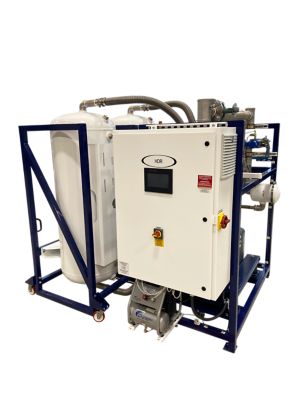Nitrous Oxide: Pain Relief or Harmful for the Environment?
October 29, 2024
Nitrous oxide (N₂O), when mixed with Oxygen as a 50/50 premix, has long been a valuable tool in maternity care, offering effective pain relief during labor. However, its role as a potent greenhouse gas and contributor to ozone depletion raises important environmental concerns. This article specifically explores the use of nitrous oxide in the maternity department, it’s benefits for birthing parents, and the environmental implications of its widespread use.
The role of Nitrous Oxide in Maternity Care
In the context of maternity care, nitrous oxide is praised for its ability to provide moderate pain relief and reduce anxiety during labor. It is administered through a mask, allowing women to self-regulate their intake. This method of pain relief is especially valued for its rapid onset and short duration of action. The gas takes effect within seconds and is quickly eliminated from the body, enabling laboring mothers to stay alert and responsive.
Furthermore, nitrous oxide is non-invasive, avoiding the need for needles or IV lines, which can be a significant advantage for those seeking a less invasive form of pain management. There is also no impact on the unborn child when the laboring mother consumes this premix of gas and air, due to the metabolism rate of 0.004%.
The ability of nitrous oxide to allow women control over their pain management contributes to a sense of empowerment and autonomy during labor. This aspect is particularly important in maternity care, where personalized and respectful treatment can significantly impact the overall birth experience. Despite its benefits, it is essential to acknowledge that nitrous oxide provides less potent pain relief compared to epidurals, yet it remains a preferred choice for many due to its flexibility and minimal side effects.

The Environmental Impact
While nitrous oxide plays a vital role in labor and delivery, its environmental impact is a growing concern. Nitrous oxide is a potent greenhouse gas, with a global warming potential nearly 298 times that of carbon dioxide. This means that even small emissions can significantly contribute to climate change. Moreover, nitrous oxide is an ozone-depleting substance, participating in chemical reactions that break down the ozone layer, which protects life on earth from harmful ultraviolet radiation. The impact on the environment is further impacted by the 114-year lifecycle period that the gas remains in the atmosphere.
The medical sector, although a smaller contributor compared to agriculture and industrial processes, still adds to the cumulative emissions of nitrous oxide. In medical settings, some of the gas can leak into the atmosphere during administration, contributing to its environmental footprint. Understanding and addressing these emissions is crucial for mitigating their impact on climate change and ozone depletion.
Mitigation Strategies and Sustainable Practices
To reduce the environmental impact of nitrous oxide, several strategies can be implemented in medical settings. Capture and processing technologies are among the most effective methods. Advanced scavenging systems can capture excess nitrous oxide from the air, preventing it from being released into the atmosphere. Destruction units can then process the captured Nitrous Oxide into its natural state gases, Nitrogen and Oxygen which are beneficial to the environment, effectively eliminating its environmental threat.
Improving the efficiency of nitrous oxide use and minimizing waste is another crucial approach. Ensuring that the gas is used judiciously and only when necessary, can significantly reduce emissions. Training healthcare providers on best practices for nitrous oxide administration can enhance both efficiency and safety.
Hospitals are also exploring and promoting alternative pain relief methods with lower environmental impacts. While nitrous oxide remains a valuable tool, the development and use of greener alternatives can further reduce the environmental footprint of maternity care.
What does the Future Bring?
Nitrous oxide offers significant benefits in maternity care, providing effective pain relief and reducing anxiety during labor. However, its environmental impact as a potent greenhouse gas and ozone-depleting substance cannot be ignored. By understanding and addressing these issues through capture and processing technologies, efficiency improvements such as leak mitigation via MedGasScan, and the exploration of alternative pain relief methods, the healthcare sector can balance the benefits of nitrous oxide with the need for environmental responsibility. Through these efforts, we can ensure that both the well-being of mothers and the health of our planet are safeguarded.



